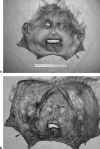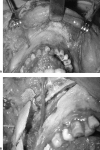Facial transplantation
- PMID: 20567679
- PMCID: PMC2884851
- DOI: 10.1055/s-2007-991196
Facial transplantation
Abstract
The face has functional and aesthetic importance. It represents the most identifiable aspect of an individual's physical being. Its role in a person's identity and ability to communicate can therefore not be overstated. The face also plays an important role in certain functional needs such as speech, communicative competence, eye protection, and emotional expressiveness. The latter function bears significant social and psychological import, because two thirds of our communication takes place through nonverbal facial expressions. Accordingly, the significance of reconstruction of the face is indisputable. Yet despite application of meticulous techniques and the development of innovative approaches, full functional and aesthetic reconstruction of the face remains challenging. This is because optimal reconstruction of specialized units of the face have to address both the functional and aesthetic roles of the face.
Keywords: Facial transplantation; allotransplantation; bioethics; reconstructive surgery.
Figures




Similar articles
-
Facial allotransplantation: a 3-year follow-up report.J Plast Reconstr Aesthet Surg. 2013 Nov;66(11):1458-63. doi: 10.1016/j.bjps.2013.06.046. Epub 2013 Aug 1. J Plast Reconstr Aesthet Surg. 2013. PMID: 23911716
-
Allotransplantation of the face: how close are we?Clin Plast Surg. 2005 Jul;32(3):401-9, vii. doi: 10.1016/j.cps.2005.02.003. Clin Plast Surg. 2005. PMID: 15979478 Review.
-
Processing communicative facial and vocal cues in the superior temporal sulcus.Neuroimage. 2020 Nov 1;221:117191. doi: 10.1016/j.neuroimage.2020.117191. Epub 2020 Jul 23. Neuroimage. 2020. PMID: 32711066
-
Complex facial reconstruction by vascularized composite allotransplantation: the first Belgian case.J Plast Reconstr Aesthet Surg. 2015 Mar;68(3):362-71. doi: 10.1016/j.bjps.2014.11.005. Epub 2014 Nov 20. J Plast Reconstr Aesthet Surg. 2015. PMID: 25488328
-
Technology and the environment: supportive resource or barrier for people with developmental disabilities?Nurs Clin North Am. 2003 Jun;38(2):331-49. doi: 10.1016/s0029-6465(02)00053-1. Nurs Clin North Am. 2003. PMID: 12914311 Review.
Cited by
-
Management of Avulsive Soft Tissue Ballistic Facial Injuries.Semin Plast Surg. 2025 Mar 26;39(1):49-56. doi: 10.1055/s-0045-1801876. eCollection 2025 Feb. Semin Plast Surg. 2025. PMID: 40160840 Review.
-
Manipulating adrenergic stress receptor signalling to enhance immunosuppression and prolong survival of vascularized composite tissue transplants.Clin Transl Med. 2022 Aug;12(8):e996. doi: 10.1002/ctm2.996. Clin Transl Med. 2022. PMID: 35994413 Free PMC article.
-
A review of the world's published face transplant cases: ethical perspectives.Scars Burn Heal. 2017 Mar 21;3:2059513117694402. doi: 10.1177/2059513117694402. eCollection 2017 Jan-Dec. Scars Burn Heal. 2017. PMID: 29799566 Free PMC article. Review.
-
Chronic rejection models for vascularized composite tissue allotransplantation.Sci Rep. 2025 May 15;15(1):16882. doi: 10.1038/s41598-025-01803-8. Sci Rep. 2025. PMID: 40374749 Free PMC article.
-
Improved Cuff Technique and Intraoperative Detection of Vascular Complications for Hind Limb Transplantation in Mice.Transplant Direct. 2018 Feb 2;4(2):e345. doi: 10.1097/TXD.0000000000000756. eCollection 2018 Feb. Transplant Direct. 2018. PMID: 29464206 Free PMC article.
References
-
- Siemionow M, Agaoglu G. In: Siemionow MZ, editor. Tissue Surgery. London: Springer-Verlag; 2006. Perspectives for facial allograft transplantation in humans. pp. 119–134.
-
- Rohrich R J, Longaker M T, Cunningham B. On the ethics of composite tissue allotransplantation (facial transplantation) Plast Reconstr Surg. 2006;117:2071–2073. - PubMed
-
- Siemionow M, Ozmen S, Demir Y. Prospects for facial allograft transplantation. Plast Reconstr Surg. 2004;15:1421–1428. - PubMed
-
- Pallua N, von Heimburg D. Pre-expanded ultra-thin supraclavicular flaps for (full-) face reconstruction with reduced donor-site morbidity and without the need for microsurgery. Plast Reconstr Surg. 2005;115:1837–1844. discussion 1845–1847. - PubMed
-
- Erol O O. The transformation of a free skin graft into a vascularized pedicled flap. Plast Reconstr Surg. 1976;58:470–477. - PubMed

